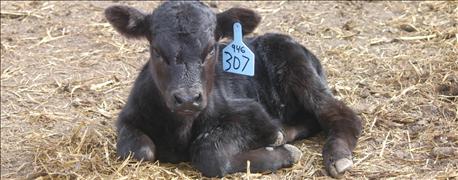March 21, 2016

Should you change to May calving? This year, the March weather has been perfect for calving. But that doesn’t always happen. And it takes a lot less labor to calve in May rather than March.
One rap against May calving is that cows would have to be bred during the heat of August, rather than cool of June. Will the pregnancy rate be as good in August as in June?
The Dickinson, N.D., Research and Extension Center hasn’t seen decline, reports Kris Ringwall, NDSU beef specialist.
The Center has been calving in May since the 2012 calf crop. Prior to 2012, the center herd calved in March.

Weather conditions are perfect this year for this young calf, but that's no always the case. May weather might be better.
For the 2009, 2010 and 2011 March/April calving, the center turned bulls out about June The average date that the third mature cow calved during those years was March 15, with the average calving date being March 29.
Rebreeding statistics were excellent, Ringwall says. Average pregnancy percentage of 99; percentage of cows calving, 98; and the percentage of cows weaning a calf, 92. The percentage of cows calving in 42 days was 95.2 and calf death loss percentage was 6.5. The cows’ average age was 4.8 years, average cow weight was 1,307 pounds and the average cow condition score was 5.6.
Overall, herd reproduction at the center was greater than the Cow Herd Appraisal Performance System benchmark values. The current CHAPS benchmarks for pregnancy are 93.1% (center, 99%), calving 92.5%, (center, 98%) and weaning 89.8% (center, 92%). The benchmarks for cows calving in 42 days is 86.4% (center, 92.5%) and calf death loss is 3.4 %(center, 6.5%).
Primarily due to the shortage of labor, recent adverse weather and the ever-increasing costs, the center changed and delayed the turnout of the bulls to about Aug. 1 for 2012, 2013 and 2014. The average date that the third mature cow calved during those years was May 7, with the average calving date being May 25.
Rebreeding of the May- and June-calved cows has been excellent, too, Ringwall says, with an average pregnancy percentage of 98; percentage of cows calving, 97; and the percentage of cows weaning a calf, 94. The percentage of cows calving in 42 days was 95.2 and the average calf death loss percentage was 3.7. The cows’ average age was 5 years, average cow weight was 1,437 pounds and the average cow condition score was 5.3.
The reproductive performance of the cows on pasture when the center was calving in March/April was very similar to the performance of cows on pasture when calving in May/June. Shifting the calving date to May did not significantly change the reproductive performance of the cow herd, Ringwall says.
Source: NDSU Extension Communications
You May Also Like




